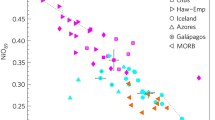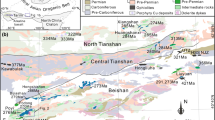Abstract
Kyser, O'Neil, and Carmichael (1981, 1982) measured theδ 18O values of coexisting minerals from peridotite nodules in alkali basalts and kimberlites, interpreting the nodules as equilibrium assemblages. Based mainly on the systematics revealed inδ 18O-olivinevs. δ 18O-pyroxene diagrams, we have re-interpreted the Kyser et al. data as non-equilibrium phenomena. On suchδ-δ diagrams, the mantle nodules exhibit data arrays that cut across theΔ 18O=zero line; these arrays strongly resemble the non-equilibrium quartz-feldspar and feldspar-pyroxeneδ 18O arrays that we now know arediagnostic of hydrothermally altered plutonic igneous rocks. Thus, the peridotites appear to have been open systems that underwent metasomatic exchange with an external, oxygen-bearing fluid (CO2 magma, H2O, etc.); during this event, the relatively inert pyroxenes exchanged at a much slower rate than did the coexisting olivines and spinels. This accounts for the correlation betweenΔ 18O pyroxene-olivine and the whole-rockδ 18O of the peridotites, which is a major difficulty with the equilibrium interpretation. The metasomatic18O-enrichments of the peridotites can be related to metasomatic enrichments in LIL elements and the development of amphibole and phlogopite. This type of precursor metasomatic activity can explain the development of alkali basalt magmas, as well as leucitites and nephelinites (all of which tend to be slightly18O-rich relative to MORB, withδ 18O=+6 to +7.5). Fluids with appropriateδ 18O values to explain the open-system metasomatic effects can be produced by exchange with ancient subducted oceanic crust (eclogite). However, fluid/rock ratios of about 0.4 to 2.5 are required, indicating that this cannot be a mantle-wide phenomenon. Also, these non-equilibrium effects are apparently transient phenomena, probably associated with the eruptive events that brought the nodules to the surface; at characteristic mantle temperatures, the effects would likely disappear in a few tens of millions of years, or less, implying that the ultramafic nodules are not typical samples of the upper mantle.
Similar content being viewed by others
References
Anderson DL (1982a) Isotopic evolution of the mantle. Earth Planet Sci Lett 57:1–24
Anderson DL (1982 b) Kimberlite and the evolution of the mantle. Proc 3rd International Kimberlite Conference ”Developments in Petrology”
Bigeleisen J, Mayer MG (1947) Calculation of equilibrium constants for isotopic exchange reactions. J Chem Phys 15:261–267
Boettcher AL, O'Neil JR (1980) Stable isotope, chemical, and petrographic studies of high-pressure amphiboles and micas: evidence for metasomatism in the mantle source regions of alkali basalts and kimberlites. Am J Sci Jackson Vol 280A:594–621
Bottinga Y, Javoy M (1975) Oxygen isotope partitioning among the minerals in igneous and metamorphic rocks. Rev Geophys Space Phys 13:401–418
Boyd FR (1973) A pyroxene geotherm. Geochim Cosmochim Acta 37:2533–2546
Clayton RN (1981) Isotopic thermometry. In: Newton RC, Navrotsky A, Wood BJ (eds) The Thermodynamics of Minerals and Melts. Springer Berlin Heidelberg New York 85–109
Clayton RN, Epstein S (1958) The relationship between18O/16O ratios in coexisting quartz, carbonate, and iron oxides from various geological deposits. J Geol 66:352–373
Clayton RN, Epstein S (1961) The use of oxygen isotopes in high-temperature geological thermometry. J Geol 69:447–452
Clayton RN, Onuma N, Mayeda TK (1971) Oxygen isotopic fractionation in Apollo 12 rocks and soils. Geochim Cosmochim Acta 35 (Suppl) 2:1417–1420
Coleman RG, Lee DE, Beatty IB, Brannock WW (1965) Eclogites and eclogites: their differences and similarities. Geol Soc Am Bull 76:483–508
Criss RE, Taylor HP Jr (1983) An18O/16O andD/H study of Tertiary hydrothermal systems in the southern half of the Idaho batholith. Geol Soc Am Bul 94:640–663
Dawson JB (1980) Kimberlites and their xenoliths. Springer Berlin Heidelber New York pp 1–252
Desmons J, O'Neil JR (1978) Oxygen and hydrogen isotope compositions of eclogites and associated rocks from the eastern Sesia Zone (Western Alps, Italy). Contrib Mineral Petrol 67:79–85
Finnerty TA (1977) Exchange of Mn, Ca, Mg, and Al between synthetic garnet, orthopyroxene, clinopyroxene and olivine. Carnegie Inst Washington Yearb 76:572–579
Frey FA, Prinz M (1978) Ultramafic inclusions from San Carlos, Arizona: Petrology and geochemical data bearing on their petrogenesis. Earth Planet Sci Lett 38:129–176
Fujii T (1977) Fe-Mg partitioning between olivine and spinel. Carnegie Inst Washington Yearb 75:566–571
Garlick GD, Epstein S (1967) Oxygen isotope ratios in coexisting minerals of regionally metamorphosed rocks. Geochim Cosmochim Acta 31:181–214
Garlick GD, MacGregor ID, Vogel DE (1971) Oxygen isotope ratios in eclogites from kimberlites. Science 172:1025–1027
Gregory RT, Taylor HP Jr (1981) An oxygen isotope profile in a section of Cretaceous oceanic crust. Samail ophiolite. Oman: Evidence forδ 18O-buffering of the oceans by deep (>5 km) seawater-hydrothermal circulation at mid-ocean ridges. Journal of Geophysical Research 86:2737–2755
Gregory RT, Taylor HP Jr (1986) Possible non-equilibrium oxygen isotope effects in mantle nodules, a criticism of the Kysen-O'Neil-Carmichael18O/16O geothermometer. Contrib Mineral Petrol 93:114–119
Gregory RT, Criss RE, Taylor HP Jr (1981) Analytical models of18O systematics of coexisting minerals in hydrothermally altered plutonic rocks. EOS 62:1064
Heaton THE, Sheppard SMF (1977) Hydrogen and oxygen isotope evidence for seawater hydrothermal alteration and ore deposition, Troodos complex, Cyprus. Volcanic Processes in Ore Genesis, Spec Pap Geol Soc London 7:42–57
Helmstadt H, Doig R (1975) Eclogite nodules from kimberlite pipes of the Colorado Plateau — samples of subducted Franciscan-type oceanic lithsphere. In: Ahrens L, Dawson TB, Duncan AR, Erlank AJ (eds) Physics and Chemistry of the Earth 9, Pergamon Press New York 95–112
Henry DJ, Medaris LG Jr (1980) Application of pyroxene and olivine-spinel geothermometers to spinel peridotites in southwestern Oregon. Am J Sci Jackson Vol 280A: 211–231
Hoffman AW, White WM (1982) Mantle plumes from ancient oceanic crust. Earth Planet Sci Lett 57:1–12 and 13–24
Irving AJ (1980) Petrology and geochemistry of composite ultramafic xenoliths in alkalic basalts and implications for magmatic processes within the mantle. Am J Sci Jackson Vol 280A:389–426
Javoy M (1977) Stable isotopes and geothermometry. J Geol Soc Lond 133:609–636
Javoy M (1980)18O/16O andD/H ratios in high temperature peridotites. Colloques Internationaux du CRNS 272:279–287
Javoy M, Allegre CJ (1967) Etude de la composition de quelques eclogites: consequences petrologiques et geophysiques. Bull Soc Geol France 9:800–808
Kyser TK, O'Neil JR, Carmichael ISE (1981) Oxygen isotope thermometry of basic lavas and mantle nodules. Contrib Mineral Petrol 77:11–23
Kyser TK, O'Neil JR, Carmichael ISE (1982) Genetic relations among basic lavas and ultramafic nodules: evidence from oxygen isotope compositions. Contrib Mineral Petrol 81:88–102
Kieffer SW (1982) Thermodynamics and lattice vibrations of minerals: applications to phase equilibria, isotope fractionation, and high-pressure thermodynamic properties. Rev Geophys Space Phys 20:827–849
Lindsley DH (1983) Pyroxene thermometry. Am Mineral 68:477–493
MacGregor ID, Carter JL (1970) The chemistry of clinopyroxenes and garnets of eclogite and peridotite xenoliths from the Roberts Victor mine, South Africa. Phys Earth Planet Int 3:391–397
Magaritz M, Taylor HP Jr (1976) Oxygen, hydrogen and carbon isotope studies of the Franciscan formation, Coast Ranges, California. Geochim Cosmochim Acta 40:215–234
Matthews A, Goldsmith JR, Clayton RN (1983) Oxygen isotope fractionations involving pyroxenes: the calibration of mineral-pair geothermometers. Geochim Cosmochim Acta 47:631–644
Mori T (1977) Geothermometry of spinel lherzolites. Contrib Mineral Petrol 59:261–279
Mori T (1978) Experimental study of pyroxene equilibria in the system CaO-MgO-FeO-SiO2. J Petrol 19:45–65
Muehlenbachs K, Kushiro I (1974) Oxygen isotope exchange and equilibrium of silicates with CO2 or O2. Carnegie Inst Washington Yearb 73:232–236
O'Neil JR, Taylor HP Jr (1967) The oxygen isotope and cation exchange chemistry of feldspars. Am Mineral 52:1414–1437
Savin SM, Epstein S (1970) The oxygen and hydrogen isotope geochemistry of ocean sediments and shales. Geochim Cosmochim Acta 34:43–64
Sheppard SMF, Epstein S (1970)D/H and18O/16O ratios of minerals of possible mantle or lower crustal origin. Earth Planetary Sci Lett 9:232–239
Sheppard SMF, Dawson JB (1975) Hydrogen, carbon, and oxygen isotope studies of megacryst and matrix minerals from Lesothan and South African kimberlites. In: Ahrens LH, Dawson, JB, Duncan AR, Erlank AJ (eds) Physics and Chemistry of the Earth, Vol 9, pp 747–763. Pergamon Press, Oxford
Spooner ETC, Beckinsale RD, Fyfe WS, Smewing JD (1974)18O-enriched ophiolitic metabasic rocks from E. Liguria (Italy), Pindos (Greece), and Troodos (Cyprus). Contrib Mineral Petrol 47:41–62
Taylor HP Jr (1967) Oxygen isotope studies of hydrothermal mineral deposits. Geochemistry of Hydrothermal Ore Deposits, ed. Barnes HL; Holt, Rinehart and Winston, New York 109–142
Taylor HP Jr (1968) The oxygen isotope geochemistry of igneous rocks. Contrib Mineral Petrol 19:1–71
Taylor HP Jr (1977) Water/rock interactions and the origin of H2O in granitic batholiths. J Geol Soc London 133:509–558
Taylor HP Jr (1983) Oxygen and hydrogen isotope studies of hydrothermal interactions at submarine and subaerial spreading centers. In: PA Rona, K Bostrom, L Laubier, KL Smith (eds) Hydrothermal Processes at Seafloor Spreading Centers, Plenum Press, Vol 12, pp 83–139
Taylor HP Jr, Epstein S (1962a) Relationship between18O/16O ratios in coexisting minerals of igneous and metamorphic rocks. Part I: Principles and experimental results: Geol Soc Am Bull 73:461–480
Taylor HP Jr, Epstein S (1962b) Relationship between O18/O16 ratios in coexisting minerals of igneous and metamorphic rocks. II. Application to petrologic problems. Geol Soc Am Bull 73:675–694
Taylor HP Jr, Epstein S (1970) Oxygen and silicon isotope ratios of Lunar Rock 12013. Earth Planet Sci Lett 9:208–210
Taylor HP Jr, Coleman RG (1968) O18/O16 ratios of coexisting minerals in glaucophane-bearing metamorphic rocks. Geol Soc Am Bull 79:1727–1756
Taylor HP Jr, Forester RW (1979) An oxygen and hydrogen isotope study of the Shaergaard intrusion and its country rocks: A description of a 55 m.y. old fossil hydrothermal system. J Petrol 20:355–419
Taylor HP Jr, Gianetti B, Turi B (1979) Oxygen isotope geochemistry of the potassic igneous rocks from the Roccamonfina volcano, Roman Comagmatic region, Italy. Earth Planet Sci Lett 46:81–106
Taylor HP Jr, Turi B (1976) High-O18 igneous rocks from the Tuscan magmatic province, Italy. Contrib Mineral Petrol 55:33–54
Taylor HP Jr, Turi B, Cundari A (1986)18O/16O and chemical relationships inK-rich volcanic rocks from Australia, East Africa, Antarctica, and San Venanzo-Cupaello, Italy. Earth Planet Sci Lett 69:263–275
Turi B, Taylor HP Jr (1976) Oxygen isotope studies of potassic volcanics of the Roman Province, Central Italy. Contrib Mineral Petrol 55:1–31
Vogel DE, Garlick GD (1970) Oxygen isotope ratios in metaphorphic eclogites. Contrib Mineral Petrol 28:183–191
Wilshire HG, Pike JEN, Meyer CE, Schwarzman ED (1980) Amphibole-rich veins in lherzolite xenoliths, Dish Hill and Deadman Lake, California. Am J Sci Jackson Vol 280A: 576–593
Author information
Authors and Affiliations
Additional information
Contribution No. 4156, Publications of the Division of Geological and Planetary Sciences, California Institute of Technology
Rights and permissions
About this article
Cite this article
Gregory, R.T., Taylor, H.P. Non-equilibrium, metasomatic18O/16O effects in upper mantle mineral assemblages. Contr. Mineral. and Petrol. 93, 124–135 (1986). https://doi.org/10.1007/BF00963591
Received:
Accepted:
Issue Date:
DOI: https://doi.org/10.1007/BF00963591




